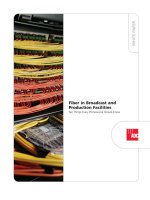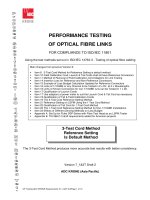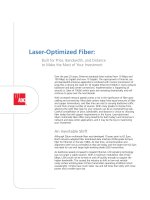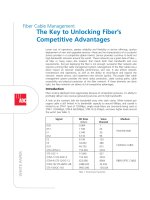Tài liệu ADC KRONE - Guide - Fiber in Broacast & Production Facility - 10 thing should know docx
Bạn đang xem bản rút gọn của tài liệu. Xem và tải ngay bản đầy đủ của tài liệu tại đây (2.99 MB, 12 trang )
WHITE PAPER
Fiber in Broadcast and
Production Facilities
Ten Things Every Professional Should Know
For years, television broadcasters have relied on coax cable to route video
and audio control signals and RF around their facilities. Coax has proven
itself to be easy to work with and reliable. However, as the television
broadcast business evolves from a single analog channel to a digital
world, the industry is re-evaluating the role of coax. In its place, fiber-
optic cable is emerging as a logical solution for next-generation television
signal routing, where greater bandwidth is needed to accommodate HD
signals and multicast SD channels.
As these applications drive fiber into more networks every day, many
broadcasters’ deployment strategies overlook one major consideration.
Good cable management practices are the key to an effective fiber
network, allowing for flexibility, fluid change, easier network maintenance
and configuration and, most importantly, growth. When a broadcaster
uses good cable management from the start in its fiber network , the
network grows more quickly. Good cable management practices also
ensure that the fiber networks of today will be ready for the higher-
bandwidth applications of tomorrow.
This paper explores the top ten things you need to know about fiber; things
you should understand when planning for an upgrade that includes fiber.
Topics covered in this paper are:
T
opic Page #
1. Key Fiber Cable Management Concepts 3
2. Making Connections 4
3. Singlemode versus Multimode 5
4. Angled versus Ultra Physical Contact Connectors 6
5. Connector Styles 7
6. Field vs. Factory Terminations 8
7. Splicing vs. Field Connectors 9
8. Slack Storage 10
9. Fiber Density 11
10. Planning for Future Growth 12
Fiber for Broadcast and Entertainment Professionals
Top Ten Things to Know
Top Ten Things to Know
Page 3
For years, broadcasters have relied on coax cable to route
video, audio and control signals and RF around their
facilities. Coax has proven itself to be relatively easy to
work with and reliable.
However, as the broadcast business evolves from a single
analog channel to a digital broadcast world, the
continued roll of coax cable is being re-evaluated. In its
place, fiber optic cable is emerging as a logical solution
for next generation signal routing, where greater
bandwidth is needed to accommodate HD signals and
multicast SD channels.
Unfortunately, the knowledge that broadcast engineers
have gained about working with coax cable isn’t
particularly transferable to using fiber. New issues, such
as signal attenuation or complete loss from severe
bending, proper troughing, crush load tolerance, and
cable density and accessibility, must be considered when
managing a fiber optic network.
Proper cable management practices make fiber networks
less susceptible to accidental damage, quicker to install,
less expensive to own and operate over the long haul
and easier to expand as needs grow.
Key cable management concepts include:
• Bend radius: At turns in fiber runs, maintain a 1.5-inch
bend radius. Tighter bends may cause micro-bending
of individual fibers that allow light to escape the signal
path, resulting in signal attenuation. More severe
bends can break fiber strands completely, resulting in
signal loss.
• Cable troughing: Used to route fiber optic cable,
troughing systems provide a protected pathway for
fiber to traverse spans between rooms and equipment
racks. Good troughing systems will keep fiber separate
from coax cable, protect it from out-of-tolerance
bends and promote neat, easily accessible runs.
• Vertical cable protection: Allowing fiber to hang
unprotected from the back of equipment can be a
recipe for disaster. Exposed cables are easy to snag
accidentally with a hand or foot, which can result in
damage to the connector or fiber itself. Additionally,
over time the weight of hanging fiber can cause
bends outside the acceptable limit and consequential
damage to the fiber. Proper vertical cable
management in panels or equipment bays provides
adequate support, cable protection and a transition
from the vertical run to the back of the equipment
that does not damage the fiber.
• Cable pile-up: In horizontal fiber runs, it is
unacceptable to allow a pile of fiber cable to exceed
two inches. Beyond that point, the weight of the
bundle will surpass the crush tolerance limit of the
fiber at the bottom of the stack, resulting in
microscopic damage and signal attenuation.
• Cable segregation: Keep fiber runs separate from legacy
coax cable. Coax is relatively heavy and can crush fiber
cables. Additionally, segregating coax from fiber ensures
that technicians repairing coax do not accidentally
damage the fiber cable while working on the copper.
• Labeling: Develop good labeling practices. Know where
fibers originate and terminate. Doing so will reduce
maintenance time and the likelihood that a maintenance
tech will make hasty decisions on fiber routing that can
lead to a rat’s nest of cable and patch cords.
• Density: When selecting products for a fiber network,
remember future maintenance. The more densely
connectors are packed onto a panel, the more difficult
it will be for even the most dexterous technicians to
maintain. Remember, inevitably cables will be moved,
so the ability to trace and re-route them is critical to
working efficiently.
• Future proofing: When planning rack configurations
with a given number of terminations to accommodate
a relatively low number of fibers for today’s
requirements, don’t forget the future. A fiber path
that easily supports 12 fibers today may be inadequate
to support the 200 fibers needed in a few years.
Planning up front for the future can save the expense
of ripping out outgrown capacity down the road.
Proper cable management is extremely important to the
successful conversion of broadcasters from coax to fiber.
The fact that a single fiber may transmit mission-critical
signals, such as revenue-generating commercials and
programming, underlies the importance of taking the
steps necessary to manage fiber’s installation and use.
Point at Which
Light is Lost
From Fiber
Optical Fiber
Light Pulse
Macrobend
Area
in Which
Light is
Lost From
Fiber
Optical Fiber
Light Pulse
Radius of
Curvature
1) Key Fiber Cable Management Concepts
Microbend
Integrating fiber into a broadcast facility requires a logical
means of connecting various devices throughout the
facility for production, playback and post-production
tasks, not unlike what has been done for years with coax
cable, patch panels and routing switchers.
On the most basic level, there are three approaches to
network architecture:
• Direct connect: This approach is straightforward, but
exceedingly limited. The output of one device is
connected to the input of another. While the least
costly of the three, it is inflexible and requires
manually moving cables at potentially far-flung source
and destination points in order for them to be
reconfigured. This approach has limited usefulness in
broadcast applications.
• Interconnect: This architecture relies on a passive
patch panel to act as an intermediate point where
fiber from devices like tape machines and still stores
can be connected. While eliminating the need to hike
to remote equipment locations to remove a cable from
one device so that it can be reconnected to another,
the interconnect architecture isn’t without its
downside. The lack of circuit access makes remote
monitoring, testing and patching impossible.
• Cross-connect: With a centralized cross-connect
patching system, achieving the dual requirements of
lower costs and highly reliable service is possible. In
this simplified architecture, all network elements have
permanent equipment cable connections that are
terminated once and never handled again.
Technicians isolate elements, connect new elements,
route around problems, and perform maintenance and
other functions using semi-permanent patch cord
connections on the front of a cross-connect system. Here
are a few key advantages provided by a well-designed
cross-connect system:
• Lower operating costs: Compared to the other
approaches, cross-connect greatly reduces the time it
takes for adding cards, moving circuits, upgrading
software, and performing maintenance. Because all
changes are made at one convenient location,
technicians are able to quickly and accurately perform
their work.
• Improved reliability and availability: Permanent
connections protect equipment cables from daily
activity that can damage them. Moves, adds, and
changes are effected on the patching field instead of
on the backplanes of sensitive routing and switching
equipment, enabling changes in the network without
disrupting service. With the ability to isolate network
segments for troubleshooting and reroute circuits
through simple patching, technicians can perform
maintenance without service downtime during regular
hours instead of during night or weekend shifts.
These three approaches to fiber network design and
signal routing offer an ascending ladder of flexibility,
convenience and control. On the bottom rung is direct
connection between devices. For broadcast applications,
this configuration is not recommended. The interconnect
architecture is most practical approach when there is
limited rerouting of inputs and outputs and circuit access
is not important. The cross-connect architecture stands
at the top of the ladder, providing the flexibility and
reliability broadcasters need in signal routing.
Top Ten Things to Know
Page 4
2) Making Connections: Direct, Interconnect and Cross-Connect Approaches
Direct Connect
Cross-Connect
Interconnect
Top Ten Things to Know
Page 5
As the broadcast industry makes its transition from
analog service to Digital TV, broadcasters are being asked
to address issues they hadn’t considered even a few years
ago. What’s the right mix of multicast DTV channels?
Should HD programming be originated locally or should
SD be upconverted? What sort of DTV transmission
scheme is appropriate? Will distributed transmission solve
coverage problems and if so, how will STLs to multiple
digital transmitter sites best be accomplished?
With each new question comes a growing recognition
that the existing plant must be upgraded or in extreme
cases replaced entirely to answer the demands of
broadcasting in a digital world.
As broadcast engineers grapple with these questions, the
need has never been greater to route more signals
between more devices with greater bandwidth. Whether
it’s HD studio cameras, multiple STL links or distribution
of wide band signals throughout the station, fiber optic
cable offers an affordable alternative to copper coax
cable. Additionally, its greater bandwidth capacity future-
proofs installations as increased bandwidth demands are
more easily accommodated than with copper.
Fiber optic cable comes in two varieties: singlemode and
multimode. Both have applications for broadcasters.
Singlemode fiber optic cables transmit a single ray of
light used to carry modulated signals. It is normally used
in applications requiring the transmission of signals over
a long distance. In the broadcast industry, singlemode
fiber is well-suited for applications such as studio-to-
transmitter links, camera control units and runs from a
studio to satellite earth stations or to cable headends, or
between separate facilities on a broadcast campus.
Multimode fiber optic cable carries multiple light rays
with different reflection angles within the fiber core.
With a fiber core that’s thicker than singlemode fiber,
multimode cable is better suited for short runs, such as
those between equipment and panels in broadcast
facilities. Multimode may be used to feed routers,
servers, editing stations and video servers.
Replacing copper with fiber is no longer economically
impractical at broadcast facilities. Once regarded as
expensive, the proliferation of fiber for business LANs
and WANs and its use in telecommunications
networks has brought an economy of scale to bear for
fiber cable, connectors and components that can
benefit broadcasters.
A recent study comparing the costs of first-time
installations of fiber with copper (CAT5, CAT5e and
CAT6) found that an “all-fiber solution offered a lower
total initial cost than the UTP-fiber network” for 12
scenarios that were studied.
According to the study, conducted by Pearson
Technologies Inc. and the Fiber Optics LAN Section of the
Telecommunications Industry Association, “In many cases
deploying multimode fiber cable throughout the network
is significantly less expensive than installing new grades
of UTP copper cable.”
These new marketplace realities could not have been
timed any better for broadcasters grappling with how to
modernize their facilities for the demands of DTV in a
cost-effective way.
Fiber offers other benefits broadcasters will find
attractive. On a physical level, it requires far less space
than coax. Fiber connectors are also physically smaller
than their coax counterparts.
Additionally, fiber optic cable offers broadcasters a level of
security that exceeds copper or microwave transmission
because it is difficult to tap without breaking.
3) Singlemode versus Multimode Fiber
Fiber Applications in a
Broadcast Family









